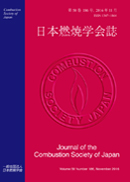Volume 46, Issue 135
Displaying 1-6 of 6 articles from this issue
- |<
- <
- 1
- >
- >|
FEATURE—New Techniques of Laser Measumenent for Spray
-
Article type: FEATURE
2004Volume 46Issue 135 Pages 12-19
Published: 2004
Released on J-STAGE: October 24, 2019
Download PDF (989K) -
Article type: FEATURE
2004Volume 46Issue 135 Pages 20-27
Published: 2004
Released on J-STAGE: October 24, 2019
Download PDF (985K) -
Article type: FEATURE
2004Volume 46Issue 135 Pages 28-34
Published: 2004
Released on J-STAGE: October 24, 2019
Download PDF (773K)
SERIAL LECTURE—Radiation and Combustion III
-
Article type: SERIAL LECTURE
2004Volume 46Issue 135 Pages 35-41
Published: 2004
Released on J-STAGE: October 24, 2019
Download PDF (802K)
ORIGINAL PAPER
-
Article type: ORIGINAL PAPER
2004Volume 46Issue 135 Pages 42-49
Published: 2004
Released on J-STAGE: October 24, 2019
Download PDF (1061K) -
Article type: ORIGINAL PAPER
2004Volume 46Issue 135 Pages 50-59
Published: 2004
Released on J-STAGE: October 24, 2019
Download PDF (1311K)
- |<
- <
- 1
- >
- >|
